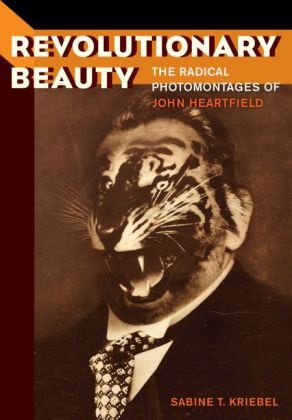Read more
Revolutionary Beauty offers the first sustained study of the German artist John Heartfield's groundbreaking political photomontages, published in the left-wing weekly Arbeiter Illustrierte Zeitung (AIZ) during the 1930s. Sabine T. Kriebel foregrounds the critical artistic practices with which Heartfield directly confronted the turbulent, ideologically charged currents of interwar Europe, exposing the cultural politics of the crucial historical moment that witnessed the consolidation of National Socialism. Kriebel transforms our understandings of montage as a quintessentially modern practice. Central to that reconceptualization is suture, a concept integral to film theory but recruited in this book to explore the psychic operations of Heartfields seamlessly welded AIZ photomontages. Revolutionary Beauty proposes that the language of sutured illusionism constitutes one of the most important and overlooked critiques of modern media, wherein a radical reassessment resides in suture. Scholars of photography, modern and contemporary art history, media studies, and European history will doubtlessly embrace this book.
List of contents
Acknowledgments
List of Abbreviations
Introduction: Photomontage, Paradigm of the Modern
1. The Subject in Circulation
2. Photomontage in the Age of Technological Reproducibility
3. Photomontage in the Year 1932
4. Left-Wing Laughter
5. Revolutionary Beauty
Epilogue: To Gratify a Wish
Notes
Selected Bibliography
List of Illustrations
Index
About the author
Sabine Kriebel is Lecturer (permanent), Modern and Contemporary Art, at University College Cork, Republic of Ireland. She completed her PhD in 2003 at UC Berkeley.
Summary
Revolutionary Beauty offers the first sustained study of the German artist John Heartfield's groundbreaking political photomontages, published in the left-wing weekly Arbeiter Illustrierte Zeitung (AIZ) during the 1930s. Sabine T. Kriebel foregrounds the critical artistic practices with which Heartfield directly confronted the turbulent, ideologically charged currents of interwar Europe, exposing the cultural politics of the crucial historical moment that witnessed the consolidation of National Socialism. In this period of radicalization and mass mobilization, the medium of photomontage—the cut-and-paste assemblage of photograph and text—offered a way to deconstruct the visual world and galvanize beholders on a mass scale.
Kriebel transforms our understandings of montage as a quintessentially modern practice. Central to that reconceptualization is suture, a concept integral to film theory but recruited in this book to explore the psychic operations of Heartfield’s seamlessly welded AIZ photomontages. Revolutionary Beauty proposes that the language of sutured illusionism constitutes one of the most important and overlooked critiques of modern media, wherein a radical reassessment resides in suture. Scholars of photography, modern and contemporary art history, media studies, and European history will doubtlessly embrace this book.
Additional text
Revolutionary Beauty covers an extraordinary amount of ground in order to situate Heartfield as an historical producer... This remarkable amalgamation of broadly historicizing and deeply analytical reconsiderations of relatively iconic things is the great strength of this book."
Report
"Historically precise and theoretically astute, this is by far the most wide-ranging study of John Heartfields extraordinary project to date. Sabine Kriebel goes beyond a single oeuvre to unearth, patiently but provocatively, the complex visual imaginary of the Left in the darkest moments of its history." - Frederic J. Schwartz, author of Blind Spots: Critical Theory and the History of Art in Twentieth-Century Germany and The Werkbund: Design Theory and Mass Culture Before the First World War

